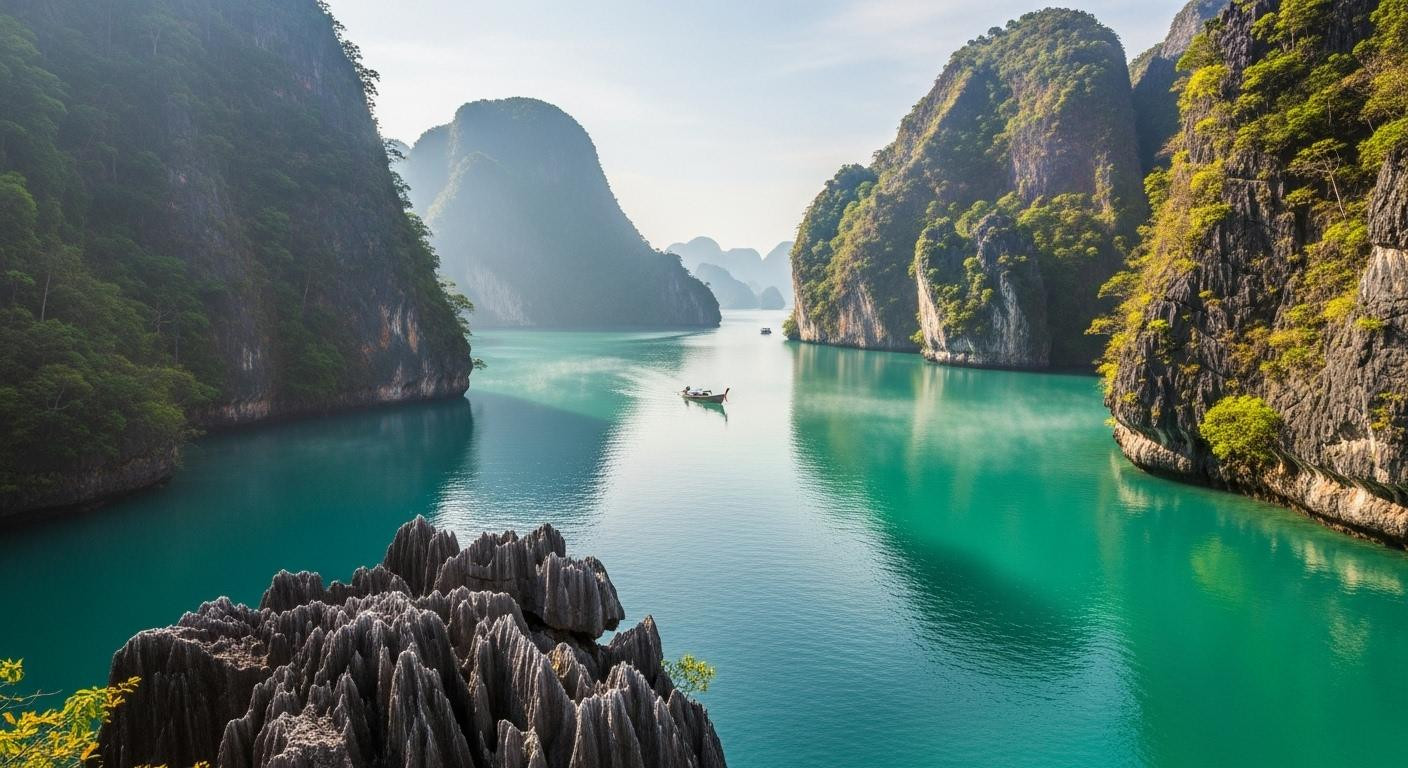Dawn breaks at 6:47 AM over Koh Hong Lagoon as morning mist lifts from emerald water. A Thai fisherman poles his longtail boat through narrow limestone channels while tour boats sleep at distant docks. This is the 90-minute window before day-trippers arrive. The sacred morning hour when 10 lagoons worldwide reveal why locals guard them fiercely.
From Palau’s UNESCO waters to Greece’s volcanic pools, these sanctuaries survived tourism’s appetite by staying invisible. No Instagram geotags. No cruise ship itineraries. Just turquoise water, profound silence, and communities who remember what mass tourism destroyed elsewhere.
The lagoons mass tourism never found
While 2 million tourists crowd Boracay annually, Puerto Balandra in Mexico welcomes fewer than 50,000 visitors. The contrast reveals everything about these hidden sanctuaries. Rock Islands Lagoon in Palau hosts just 20,000 travelers yearly despite UNESCO World Heritage status.
Limestone reflections shimmer across Koh Hong’s emerald surface. Salt-scented air carries no engine noise at dawn. The two-boat limit enforced by Thai park rangers preserves what Phuket lost decades ago. These 10 under-the-radar U.S. sanctuaries offer similar protection through isolation rather than regulation.
Crystal Lake in Oregon receives 400,000 annual visitors. Yet its remote location and seasonal access keep crowds manageable. Compare this to Yellowstone’s 4.9 million yearly guests. The difference creates the tranquility these lagoons protect.
What makes these waters feel like time stopped
Crystal clarity that defies belief
Linapacan Island in the Philippines claims the world’s clearest waters. Boats appear to float on air above 40-foot depths. The island’s 14,180 residents maintain fishing traditions that preserve water quality. No industrial runoff. No resort development. Just pristine clarity that rivals the Maldives at half the cost.
Crater Lake’s volcanic origins create 143-foot visibility through sapphire water. The 1,943-foot depth reflects nothing but endless blue sky. Ancient geological forces carved these sanctuaries. This 7,283-foot French lake shares similar healing properties through altitude and isolation.
Limestone cathedrals and natural amphitheaters
Rock Islands Southern Lagoon features 445 limestone formations creating acoustic silence. Wind and waves disappear within these natural walls. Secret Lagoon at El Nido requires passage through a narrow rock opening. The enclosed cavity muffles outside noise completely.
Angel’s Billabong in Indonesia showcases volcanic architecture. Black rock frames turquoise infinity pools. Tide schedules determine access windows. Only 2-hour periods allow safe swimming. This natural timing system prevents overcrowding automatically.
The morning rituals tourists never witness
Dawn at the water’s edge
Puerto Balandra locals arrive at 6:30 AM spreading blankets on white sand. Coffee scents mix with salt air before tourist heat arrives. Greek grandmothers swim at Giola Lagoon before hiking crowds begin their sun-baked journeys. Cool volcanic rock provides natural seating.
Palau fishermen conduct pre-dawn reef checks using traditional methods. Their longtail boats glide silently across mirror-smooth water. These 10 U.S. islands locals quietly protect maintain similar morning traditions that tourists rarely experience.
Water temperature reaches perfect 78°F by 7 AM in tropical locations. Alpine lakes like Crater Lake remain refreshingly cool at 65°F even in summer. Each lagoon offers distinct thermal experiences shaped by geology and elevation.
Where locals actually swim
Mayreau’s 300 residents use double-sided beaches that cruise ships can’t access. Caribbean conch preparation happens on these shores using recipes passed down through generations. Fresh ceviche vendors at Puerto Balandra serve fishermen before tourist boats depart.
Thai longtail boat operators deliver breakfast to Koh Hong’s secluded beaches. Rice porridge and fresh fruit fuel morning snorkeling sessions. These authentic experiences cost $5-10 compared to resort breakfast prices of $40-50.
The conservation stories behind the silence
Rock Islands implemented daily boat quotas in 2025 after visitor numbers threatened coral reef health. Koh Hong National Park enforces strict two-boat limits through ranger patrols. Puerto Balandra gained marine sanctuary designation preventing resort development proposals.
Linapacan fishermen created self-imposed conservation rules protecting spawning areas. Tourism revenue increased from $12.5 billion in 2022 to $24.8 billion in 2023 across Palawan province. Growth happened without destroying water clarity that attracts visitors initially. This $1,500 Philippines budget shows how sustainable tourism benefits both communities and travelers.
The unspoken covenant exists everywhere. Visitors who find these places must protect them by avoiding geotagging and respecting boat limits. Local tourism boards confirm this approach maintains the serenity that makes these lagoons special.
Your questions about 10 secret lagoons that look straight from a dream answered
When do these lagoons stay crowd-free?
Rock Islands and Puerto Balandra remain peaceful November through April during dry seasons. Koh Hong offers solitude before 9 AM year-round. Crater Lake stays accessible July through September only. Giola provides the best experience May through October at dawn. Angel’s Billabong depends on tide schedules varying daily.
What’s the real cost compared to resort destinations?
Linapacan beachfront cottages start at $40 nightly versus Maldives overwater bungalows costing $700-plus. Mayreau eco-cottages range $70-120 compared to Caribbean resort hotels at $400-plus. Crater Lake park entry costs just $30 per vehicle. Most lagoons offer authentic experiences at 60-80% less than commercialized alternatives.
How do locals protect these without closing them entirely?
Koh Hong’s two-boat limit gets enforced by park rangers conducting regular patrols. Secret Lagoon El Nido charges $15 entrance fees funding reef protection programs. Rock Islands requires advance booking for daily boat quotas introduced in 2025. Community-led visitor education at Puerto Balandra and Mayreau teaches sustainable practices.
At Angel’s Billabong, the tide recedes at 7:15 AM revealing infinity pools carved in volcanic black rock. An Indonesian grandmother descends barefoot, her morning ritual unchanged for decades. The turquoise water reflects nothing but sky. This is what locals protect: not the lagoon itself, but the silence that makes it sacred.
